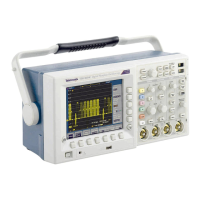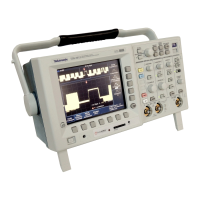University of Portland - p. 6 of 9 - Oscilloscope - TDS3012B.docx
Triggering
The oscilloscope repeatedly draws the input voltage on the screen from left to right, then returns
to the left side and draws the signal again on top of the previous curve. Each time the
oscilloscope draws the signal, it is called a sweep. If the oscilloscope did not have a way to
arrange it so each sweep started at the same point in the period for periodic signals, the screen
would display multiple sweeps, which would interfere with taking measurements (see Figure 10).
Figure 10: Oscilloscope is not triggering properly
Triggering is a mechanism that causes the oscilloscope to pause the sweep at the left side of the
screen until the input voltage crosses a user-selected voltage called the trigger level. This causes
each sweep to start in the same point in the period for periodic signals, and leads to a stable
display.
If the input signal never crosses the trigger level, the oscilloscope will wait for about a second,
and then it will draw the sweep. In this case the display may appear to drift across the screen or
may have several sweeps superimposed on the screen at the same time. Either way, it is difficult
or impossible to make measurements if the oscilloscope is not triggering properly.
The trigger level knob controls the trigger level (see Figure 11). In order for the oscilloscope to
trigger properly, the trigger level must be set to a voltage that the input signal crosses.
Figure 11: Trigger Level Knob

